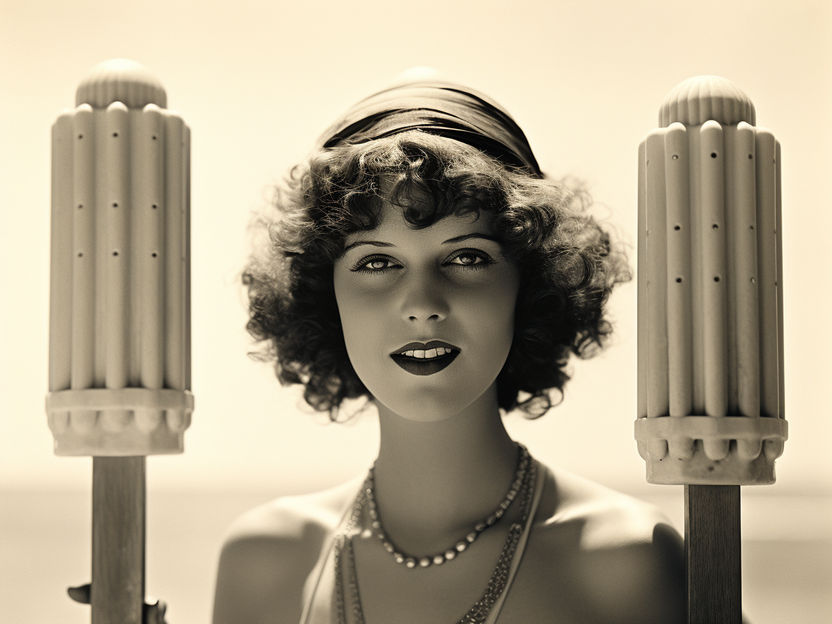Dispute 100 years ago: Who put the stick in the ice first?
A drink forgotten on a cold night supposedly leads to the birth of the popsicle.
The first popsicle is said to have been invented by accident: Legend has it that the U.S. American Frank W. Epperson, as an eleven-year-old, left a syrupy drink out in the open with a stirring stick on a cold night in California in 1905. Overnight, he says, the liquid froze around the stem.

symbolic picture
computer generated picture
However, Epperson would later not be the first to apply for a patent for making this frozen delicacy. The U.S. confectioner Harry B. Burt beat him to the punch on October 9, 1923. At the time, this led to a dispute over the now popular invention.
Water ice on a stick: How the "Popsicle" is made
Epperson is said to have waited more than 15 years before recreating his accidental invention from the cold night. His product was water ice, which later became known as the "Popsicle" and was advertised as "A Drink on a Stick".
Almost 20 years passed since the night in 1905, and at the end of 1923 Epperson patented the "Popsicle" brand. On June 11, 1924, the Californian finally applied for a patent on the process, which was granted two months later. Around this time, he co-founded the Popsicle Company. He transferred all patent rights to the company in 1924.
The second popsicle: "Good Humor Bar
Harry B. Burt's product was milk ice cream. The confectioner took the idea from a teacher in Iowa, who patented the "Eskimo Pie" in January 1922. This is ice cream pressed into a rectangle and coated in chocolate.
What Burt does at the time: he sticks a stick into such a chocolate-covered ice cream bar, creating the "Good Humor Bar." Burt proclaims this to be "the new, clean and convenient way to eat ice cream."
After his death in 1926, Burt's widow Cora continues to run the company, but quickly sells it to Midland Food Products. That company then renames itself the Good Humor Corporation.
How the popsicle controversy came about
At the time, standardization of products was still relatively unheard of. The "Good Humor Bar" treat was supposed to have the same ingredients and the same taste everywhere. Therefore, in early 1922, Burt applies for patents for the process, the manufacturing apparatus and the product. On October 9, 1923, he receives it for the process and the machinery. However, a patent is never granted for the product itself.
Nevertheless, Burt claims ownership of all forms of frozen confectionery on a stick. To the June 1925 issue of The Ice Cream Review, Burt says he is "many months ahead of all other patents." The Ohio confectioner sends a warning afterward:
"Our royalties are small, and far less than the cost of litigation an infringer would face."
Legal war over popsicle begins
No sooner said than done, Burt files suit against its main competitor, the Popsicle Corporation, in 1925. From then on, there was a legal back-and-forth between the companies. Finally, in the fall of 1925, Burt reached a licensing agreement with Popsicle.
Parties to the dispute clarify content and form
In it, the two parties divide up the market: The license would apply only to popsicles consisting of "flavored syrup, water ice or sorbet" and "frozen on the stick."
The licensor - i.e., Burt - retains "all other rights." This includes products made from "ice cream, frozen custard or the like." The appearance is also clarified: from now on, the cylindrical shape is reserved for the "Popsicle", while Burt's "Good Humor Bar" has a rectangular shape.
Popsicle enrages Good Humor again
Under pressure from some licensees and because of the falling price of milk, Popsicle comes up with the idea of also offering a cheap ice cream product. This leads to a final legal battle with Good Humor.
The license agreement from 1925 allows Popsicle to produce sorbet, for which there is no fixed definition in the industry at that time. Popsicle aims to fill the void with a light milk ice cream called "Milk Popsicle."
In 1932 and 1933, both a district court and the court of appeals find that Popsicle is thus in violation of the 1925 agreement. Even before the verdict is reached, Popsicle and Good Humor reach an out-of-court settlement.
Who owns "Popsicle" and "Good Humor Bar" today.
The irony of the story: years of challenges and agreements no longer matter. Today, both the "Good Humor Bar" and "Popsicle" are owned and manufactured by one company: Good Humor-Breyers Ice Cream. The company belongs to the Unilever group.
Note: This article has been translated using a computer system without human intervention. LUMITOS offers these automatic translations to present a wider range of current news. Since this article has been translated with automatic translation, it is possible that it contains errors in vocabulary, syntax or grammar. The original article in German can be found here.































































